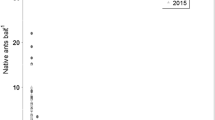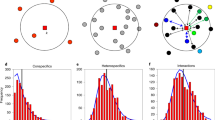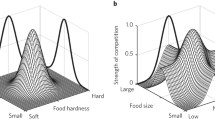Abstract
Ecologists have long sought to explain the coexistence of multiple potentially competing species in local assemblages. This is especially challenging in species-rich assemblages in which interspecific competition is intense, as it often is in ant assemblages. As a result, a suite of mechanisms has been proposed to explain coexistence among potentially competing ant species: the dominance–discovery tradeoff, the dominance–thermal tolerance tradeoff, spatial segregation, temperature-based niche partitioning, and temporal niche partitioning. Through a series of observations and experiments, we examined a deciduous forest ant assemblage in eastern North America for the signature of each of these coexistence mechanisms. We failed to detect evidence for any of the commonly suggested mechanisms of coexistence, with one notable exception: ant species appear to temporally partition foraging times such that behaviourally dominant species foraged more intensely at night, while foraging by subdominant species peaked during the day. Our work, though focused on a single assemblage, indicates that many of the commonly cited mechanisms of coexistence may not be general to all ant assemblages. However, temporal segregation may play a role in promoting coexistence among ant species in at least some ecosystems, as it does in many other organisms.




Similar content being viewed by others
References
Adams ES (1994) Territory defense by the ant Azteca trigona: maintenance of an arboreal ant mosaic. Oecologia 97:202–208
Adler FR, LeBrun EG, Feener DH (2007) Maintaining diversity in an ant community: modelling, extending, and testing the dominance–discovery trade-off. Am Nat 169:323–333
Albrecht M, Gotelli NJ (2001) Spatial and temporal niche partitioning in grassland ants. Oecologia 126:134–141
Amor F, Ortega P, Cerdá X, Boulay RR (2011) Solar elevation triggers foraging activity in a thermophilic ant. Ethology 117:1031–1039
Andersen AN (1983) Species diversity and temporal distribution of ants in the semi-arid mallee region of northwestern Victoria. Aust J Ecol 8:127–137
Andersen AN (1992) Regulation of “momentary” diversity by dominant species in exceptionally rich ant communities of the Australian seasonal tropics. Am Nat 140:401–420
Andersen AN (2008) Not enough niches: non-equilibrial processes promoting species coexistence in diverse ant communities. Austral Ecol 33:211–220
Bernstein RA (1979) Relations between species diversity and diet in communities of ants. Insect Soc 4:313–321
Bestelmeyer BT (2000) The trade-off between thermal tolerance and behavioral dominance in a subtropical South American ant community. J Anim Ecol 69:998–1009
Beugnon G, Fourcassié V (1988) How do red wood ants orient during diurnal and nocturnal foraging in a three dimensional system? II. Field experiments. Insect Soc 35:106–124
Blüthgen N, Stork NE (2007) Ant mosaics in a tropical rainforest in Australia and elsewhere: a critical review. Austral Ecol 32:93–104
Blüthgen N, Gebauer G, Fiedler K (2003) Disentangling a rainforest food web using stable isotopes: dietary diversity in a species-rich ant community. Oecologia 137:426–435
Blüthgen N, Stork NE, Fiedler K (2004) Bottom-up control and co-occurrence in complex communities: honeydew and nectar determine a rainforest ant mosaic. Oikos 106:344–358
Boulay R, Galarza JA, Chéron B, Hefetz A, Lenoir A, van Oudenhve L, Cerdá X (2010) Intraspecific competition affects population size and resource allocation in an ant dispersing by colony fission. Ecology 91:3312–3321
Carothers JH, Jaksić FM (1984) Time as a niche difference: the role of interference competition. Oikos 42:403–406
Cerdá X, Retana J, Cros S (1997) Thermal disruption of transitive hierarchies in Mediterranean ant communities. J Anim Ecol 66:363–374
Cerdá X, Retana J, Manzaneda AJ (1998) The role of competition by dominants and temperature in the foraging of subordinate species in Mediterranean ant communities. Oecologia 117:404–412
Chase JM, Leibold MA (2003) Ecological niches. University of Chicago Press, Chicago
Colley W (2002) Colley’s bias free college football ranking method. http://www.colleyrankings.com/
Davidson DW (1998) Resource discovery versus resource domination in ants: a functional mechanism for breaking the trade-off. Ecol Entomol 23:484–490
Degan AA, Gersani M (1989) Environmental effects on activity and honeydew collection by the weaver ant Polyhachis simplex (Hymenoptera: formicidae) when attending the mealybug Trabutina sp. (Homoptera: pseudococcidae). J Zool (Lond) 218:421–432
Dueser RD, Shuggart HH (1979) Niche pattern in a forest-floor small mammal fauna. Ecology 60:108–118
Dunn RR, Parker CR, Sanders NJ (2007) Temporal patterns of diversity: assessing the biotic and abiotic controls of ant assemblages. Biol J Linn Soc 91:191–201
Feener DH (1988) Effects of parasites on foraging and defence behavior of a teritophagous ant, Pheidole titans Wheeler (Hymenoptera Formicidae). Behav Ecol Sociobiol 22:421–427
Feener DH, Orr MR, Wackford KM, Longo JM, Benson WW, Gilbert LE (2008) Geographic variation in resource dominance–discovery in Brazilian ant communities. Ecology 89:1824–1836
Fellers JH (1987) Interference and exploitation in a guild of woodland ants. Ecology 68:1466–1478
Fellers JH (1989) Daily and seasonal activity in woodland ants. Oecologia 78:69–76
Fiedler K, Kuhlmann F, Schlick-Steiner BC, Steiner FM, Gebauer G (2007) Stable N-isotope signatures of central European ants–assessing positions in a trophic gradient. Insect Soc 54:393–402
Gotelli NJ, Ellison AM (2002) Assembly rules for New England ant assemblages. Oikos 99:591–599
Gotelli NJ, Entsminger GL (2010) EcoSim: null models software for ecology. Acquired Intelligence, Kesey-Bear, Jericho, VT
Gotelli NJ, Graves GR (1996) Null models in ecology. Smithsonian Institution, Washington, DC
Gotelli NJ, McCabe DJ (2002) Species co-occurrence: a meta-analysis of J.M. Diamond’s assembly rules model. Ecology 83:2091–2096
Gotelli NJ, Graves GR, Rahbek C (2010) Macroecological signals of species interactions in the Danish avifauna. Proc Natl Acad Sci USA 107:5030–5035
Gotelli NJ, Ellison AM, Dunn RR, Sanders NJ (2011) Counting ants (Hymenoptera: formicidae): biodiversity sampling and statistical analysis for myrmecologists. Myrmecol News 15:13–19
Gutman R, Dayan T (2005) Temporal partitioning: an experiment with two species of spiny mice. Ecology 86:164–173
Hölldobler B, Wilson EO (1990) The ants. Harvard University Press, Cambridge
Hubbell SP (2001) The unified neutral theory of biodiversity and biogeography. Princeton University Press, Princeton
Hutchinson GE (1959) Homage to Santa Rosalia or why are there so many kinds of animals? Am Nat 93:145–159
Kaspari M (1993) Body size and microhabitat use in neotropical granivorous ants. Oecologia 96:500–507
Kneitel JM, Chase JM (2004) Trade-offs in community ecology: linking spatial scales and species coexistence. Ecol Lett 7:69–80
Kronfeld-Schor N, Dayan T (1999) The dietary basis for temporal partitioning: food habits of coexisting Acomys species. Oecologia 121:123–128
Kunz TH (1973) Resource utilization: temporal and spatial components of bat activity in central Iowa. J Mammal 54:14–32
LeBrun EG, Feener DH (2007) When trade-offs interact: balance of terror enforces dominance discovery trade-off in a local ant assemblage. J Anim Ecol 76:58–64
Lessard JP, Dunn RR, Sanders NJ (2009) Temperature-mediated coexistence in temperate forest ant communities. Insect Soc 56:149–156
Levine JM, HilleRisLambers J (2009) The importance of niches for the maintenance of species diversity. Nature 461:254–257
Levine JM, Rees M (2002) Coexistence and relative abundance in annual plant assemblages: the roles of competition and colonization. Am Nat 160:452–467
Levings SC, Traniello JFA (1981) Territoriality, nest dispersion, and community structure in ants. Psyche 88:265–320
Lynch JF (1981) Seasonal, sucessional, and vertical segregation in a Maryland ant community. Oikos 37:183–198
Lynch JF, Balinsky EC, Vail SG (1980) Foraging patterns in three sympatric forest ant species, Prenolepis imparis, Paratrechina melanderi and Aphaenogaster rudis (Hymenoptera: formicidae). Ecol Entomol 5:353–371
MacArthur RH (1958) Population ecology of some warblers of northeastern coniferous forests. Ecology 39:599–619
Majer JD, Delabie JHC, Smith MRB (1994) Arboreal ant community patterns in Brazilian cocoa farms. Biotropica 26:73–83
McPeek MA, Grace M, Richardson JML (2001) Physiological and behavioural responses to predators shape the growth/predation risk trade-off in damselflies. Ecology 82:1535–1545
Narendra A, Reid SF, Hemmi JM (2010) The twilight zone: ambient light levels trigger activity in primitive ants. Proc R Soc Lond B 277:1531–1538
Orr MR (1992) Parasitic flies (Diptera: phoridae) influence foraging rhythms and caste division of labor in the leaf-cutter ant, Atta cephalotes (Hymenoptera: formicidae). Behav Ecol Sociobiol 30:395–402
Parr CL, Gabb H (2010) Competition and the role of dominant ants. In: Lach L, Parr CL, Abbott L (eds) Ant ecology. Oxford University Press, Oxford, pp 77–96
Parr CL, Gibb H (2011) The discovery-dominance trade-off is the exception, rather than the rule. J Anim Ecol 81:233–241
Parr CL, Sinclair BJ, Andersen AN, Gaston KJ, Chown SL (2005) Constraints and competition in assemblages: a cross-continental and modelling approach for ants. Am Nat 165:481–494
Pekas A, Tena A, Aguilar A, Garcia-Mari F (2011) Spatio-temporal patterns and interactions with honeydew-producing Hemiptera of ants in a Mediterranean citrus orchard. Agric For Entomol 13:89–97
Pfeiffer M, Tuck HC, Lay TC (2008) Exploring arboreal ant community composition and co-occurrence patterns in plantations of oil palm Elaeis guineensis in Borneo and Peninsular Malaysia. Ecography 31:21–32
Retana J, Cerdá X (2000) Patterns of diversity and composition of Mediterranean ground ant communities tracking spatial and temporal variability in the thermal environment. Oecologia 123:436–444
Ribas CR, Schoereder JH (2002) Are all ant mosaics caused by competition? Oecologia 131:606–611
Rosendell J, Hubbell SP, Etienne RS (2011) The unified theory of biodiversity and biogeography at age ten. Trends Ecol Evol 26:340–348
Ryti RT, Case TJ (1992) The role of neighborhood competition in the spacing and diversity of ant communities. Am Nat 139:355–379
Sanders NJ, Gordon DM (2003) Resource-dependent interactions and the organization of desert ant communities. Ecology 84:1024–1031
Sanders NJ, Crutsinger GM, Dunn RR, Majer JD, Delabie JHC (2007a) An ant mosaic revisited: dominant ant species disassemble arboreal ant communities but co-occur randomly. Biotropica 39:422–427
Sanders NJ, Gotelli NJ, Wittman SE, Ratchford JS, Ellison AM, Jules ES (2007b) Assembly rules of ground-foraging ant assemblages are contingent on disturbance, habitat and spatial scale. J Biogeogr 34:1–10
Sanders NJ, Lessard JP, Fitzpatrick MC, Dunn RR (2007c) Temperature, but not productivity or geometry, predicts elevational diversity gradients in ants across spatial grains. Glob Ecol Biogeogr 16:640–649
Schoener TW (1974) Resource partitioning in ecological communities. Science 185:27–30
Shigesada N, Kawasaki K, Teramoto E (1979) Spatial segregation of interacting species. J Theor Biol 79:83–99
Shorrocks B, Sevenster JG (1995) Explaining local species diversity. Proc R Soc Lond B 206:305–309
Shorrocks B, Rosewell J, Edwards K (1984) Interspecific competition is not a major organizing force in many insect communities. Nature 310:310–312
Siepielski AM, McPeek MA (2010) On the evidence for species coexistence: a critique on the coexistence program. Ecology 91:3135–3164
Silva RR, Brandão CRF (2010) Morphological patterns and community organization in leaf-litter ant assemblages. Ecol Monogr 80:107–124
Silvertown J (2004) Plant coexistence and the niche. Trends Ecol Evol 19:605–611
Stone L, Roberts A (1990) The checkerboard score and species distributions. Oecologia 85:74–79
Talbot M (1946) Daily fluctuations in aboveground activity of three species of ants. Ecology 27:65–70
Tillberg CV, McCarthy DP, Dolezal AG, Suarez AV (2006) Measuring the trophic ecology of ants using stable isotopes. Insect Soc 53:65–69
Tilman D (1994) Competition and biodiversity in spatially structured habitats. Ecology 75:2–16
Tilman D (2011) Diversification, biotic interchange, and the universal trade-off hypothesis. Am Nat 178:355–371
Torres JA (1984) Diversity and distribution of ant communities in Puerto Rico. Biotropica 16:296–303
Vepsäläinen K, Savolainen R (1990) The effect of interference by Formicine ants on the foraging of Myrmica. J Anim Ecol 59:643–654
Wiescher PT, Pearce-Duvet JMC, Feener DH (2011) Environmental context alters ecological trade-offs controlling ant coexistence in a spatially heterogeneous region. Ecol Entomol 36:549–559
Wittman SE, Sanders NJ, Ellison AM, Jules ES, Ratchford JS, Gotelli NJ (2010) Species interactions and thermal constraints on ant community structure. Oikos 119:551–559
Wright SJ (2002) Plant diversity in tropical forests: a review of the mechanisms of species coexistence. Oecologia 130:1–14
Yurewicz KL (2004) A growth/mortality trade-off in larval salamanders and the coexistence of intraguild predators and prey. Oecologia 138:102–111
Acknowledgments
We thank C. Hirsch for help in the field. Discussions with N.J. Gotelli and A.E. Ellison, and comments by H. Gibb, S.E. Kuebbing, J.P. Lessard, and two anonymous reviewers helped to improve this manuscript. D. Simberloff helped with the creating the confidence intervals for measures of dominance. R.R. Dunn and N.J. Sanders were supported by DOE-PER DE-FG02-08ER64510. Additionally, K.L. Stuble was supported by the DOE GREF and EPA STAR programs, and by the Department of Ecology and Evolutionary Biology at the University of Tennessee. G.L. McCormick was supported by a DOE SURE.
Author information
Authors and Affiliations
Corresponding author
Additional information
Communicated by Phil Lester.
Electronic supplementary material
Below is the link to the electronic supplementary material.
Rights and permissions
About this article
Cite this article
Stuble, K.L., Rodriguez-Cabal, M.A., McCormick, G.L. et al. Tradeoffs, competition, and coexistence in eastern deciduous forest ant communities. Oecologia 171, 981–992 (2013). https://doi.org/10.1007/s00442-012-2459-9
Received:
Accepted:
Published:
Issue Date:
DOI: https://doi.org/10.1007/s00442-012-2459-9




